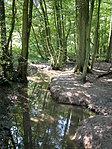Rhine-Ruhr metropolitan region

The Rhine-Ruhr metropolitan region (German: Metropolregion Rhein-Ruhr) is the largest metropolitan region in Germany, with over ten million inhabitants. A polycentric conurbation with several major urban concentrations, the region covers an area of 7,110 square kilometres (2,750 sq mi), entirely within the federal state of North Rhine-Westphalia. The Rhine-Ruhr metropolitan region spreads from the Ruhr area (Dortmund-Bochum-Essen-Duisburg) in the north to the urban areas of the cities of Mönchengladbach, Düsseldorf (the state capital), Wuppertal, Leverkusen, Cologne (the region's largest and Germany's fourth largest city), and Bonn in the south. The location of the Rhine-Ruhr at the heart of the European Blue Banana makes it well connected to other major European cities and metropolitan areas such as the Randstad, the Flemish Diamond and the Frankfurt Rhine Main Region. The metropolitan area is named after the Rhine and Ruhr rivers, which are the region's defining geographical features and historically its economic backbone.
Excerpt from the Wikipedia article Rhine-Ruhr metropolitan region (License: CC BY-SA 3.0, Authors, Images).Rhine-Ruhr metropolitan region
Mellinghofer Straße, Mülheim an der Ruhr Altstadt II (Rechtsruhr-Süd)
Geographical coordinates (GPS) Address Nearby Places Show on map
Geographical coordinates (GPS)
| Latitude | Longitude |
|---|---|
| N 51.45 ° | E 6.8833333333333 ° |
Address
Mellinghofer Straße
Mellinghofer Straße
45473 Mülheim an der Ruhr, Altstadt II (Rechtsruhr-Süd)
North Rhine-Westphalia, Germany
Open on Google Maps









